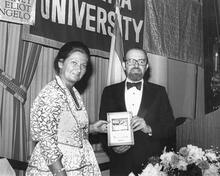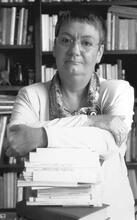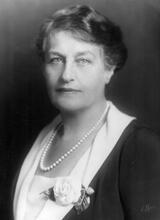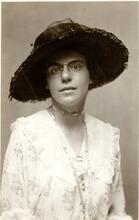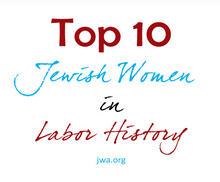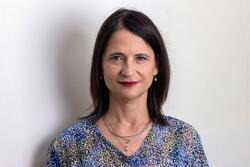Roza Shabad-Gawronska
A pediatrician specializing in the care of infants and their mothers, Roza Shabad-Gawronska was president of the OZE/TOZ (Jewish Health Care Society) in Vilna on the eve of World War II. Prior to the war, she had established the first “School for young mothers” in Vilna and worked as a school doctor. In 1939, she organized the reception of thousands of Jewish refugees arriving in Vilna. She then became active in the organization of “medical resistance” set up in the ghetto to counter the Nazis’ plans for annihilation. In the Vilna ghetto, she established all the medical and medico-social institutions for young children, including the orphanage and day care center. She was assassinated with the children of the orphanage in September 1943.
Medical Studies and Political Commitments
Roza Shabad was born on January 17, 1882, in Vilna, then in the Russian Empire, now Lithuania. She was the eldest of the four children of Isidor-Israel Shabad, an engineer and director of a paper mill in a village near Vilna, and Paulina (Pesia) Paperna.
After graduating from high school in 1899, Shabad studied medicine at the Albert-Ludwigs University of Freiburg. Many Russian Jewish women, including renowned psychiatrist Raïsa Golant, followed a similar path to high education in Western Europe, reconciling the Jewish tradition of study with the limitations imposed on the education of both Jews and women in the Russian Empire in the late nineteenth century.
In German universities, Russian Jewish students were often isolated. They grouped themselves into informal organizations or "colonies," which often discussed the political ideologies that marked the European continent at the time. Three socialist currents dominated the Russian Jewish “colonies”: Social Democrat, Socialist-Revolutionary, and the Bund. During her studies at Freiburg-in-Breisgau, Shabad joined the Socialist Revolutionary Party (SR). She also met Jacob Ossip Gawronski. They married in 1902 or 1903 and had two daughters, Vera and Nina, but they divorced before the end of Roza’s studies in Freiburg in 1908.
Shabad-Gawronska defended her thesis on December 20, 1907, at Albert-Ludwigs University. It was titled “A Case of Spasmophiler Diatese with Healing Through Breast Milk” (in German, “Ein Fall von Spasmophiler Diatese mit Heilung durch Frauenmilch”), an early indication of her interest in mothers and children.
Following her graduation from medical school in Germany, Shabad-Gawronska enrolled at the Saint Petersburg Military Medical Academy, considered one of the best educational institutions in the Russian Empire. She worked in various hospitals before and after completing her studies, and from 1912 to 1914 she volunteered at the Saint Petersburg Women’s Medical Institute. From 1914 to 1916, Shabad-Gawronska lived in Switzerland with Pavel Leontiev, the great love of her life, and her two daughters. She continued her involvement in the SR .
Shabad-Gawronska returned to St. Petersburg in 1916 and once again worked as a volunteer at the Women’s Medical Institute. Her return was possibly inspired by hopes for the end of the Tsarist regime, for the role the SR could play in Russia, and above all, for reforms carried out by doctors involved in public health. From 1917 to 1921, she worked in a hospital in Tuapse, on the shores of the Black Sea.
Interwar Dedication to Mothers and Children
In 1922, Shabad-Gawronska returned to Vilna. She worked at a clinic for mothers and children founded by Dr. Herts Kowarski, where she established the first “school for young mothers.” Through Kowarski, she also began working as a doctor at the Sofia Gurewitsh school; she then worked at a small school founded by her aunt, Anna Vygodskaia, who had trained with Maria Montessori. Shabad-Gawronska joined her uncle, Dr. Tsemakh Shabad, as a member of the Board of Directors of the Vilna branch of the Obshetsvo Zdravookranenya Yevreyev (Society for the Health Protection of the Jewish Population, founded in Saint Petersburg in 1912. In October 1923, the Vilna branch of the OZE merged with the Association for the Protection of the Health of the Jewish Population of Poland (TOZ, for Towazystwo Ochtony Zdrowia).
Shabad-Gawronska contributed to a number of the many innovations and popular medical publications on infant hygiene in the 1920s, which aimed to combat infant mortality in the aftermath of the First World War. In 1923, she published an article entitled “Infant Hygiene” in the OZE/TOZ journal Folksgezunt (People’s Health) covering many topics relating to the care of infants: the benefits of breast milk, child hygiene, swaddling, toilet training, holding an infant, air quality, regularity and quantity of feeding, and breastfeeding conditions.
In 1934, Shabad-Gawronska took over the management of the tuberculosis treatment clinic created by the OZE/TOZ, while also developing a private gynecology and obstetrics clinic practice. The only woman on the OZE/TOZ Board of Directors in 1934, she became president of the organization in the summer of 1939.
1939-1941: Mobilizations for Refugees
After the outbreak of World War II in 1939, Shabad-Gawronska made the OZE/TOZ a major player in welcoming thousands of refugees from Germany and Nazi-occupied Poland to Vilna, which had been annexed by Poland in 1920 and then by Lithuania in 1939, after the implementation of the German-Soviet Nonaggression Pact. In January 1940 alone, the OZE/TOZ welcomed 5,541 refugees in its various institutions (Bulletin No. 1 of the JDC in Vilno, February 15, 1940).
The OZE/TOZ's workload increased significantly, with daily care of refugees, the production of medicines in its own laboratories, and the use of ultraviolet production equipment for diseases such as rickets and eczema all expanding. OZE/TOZ also established an infirmary to care for the wounded after their discharge from the hospital and before their return to reception centers, installed first aid kits in dormitories and soup kitchens, and created a special kitchen for the sick. By the spring of 1940, in addition to the outpatient clinic, the OZE/TOZ had around fifteen locations, including a mental hygiene consultation center, an X-ray treatment center, a children's sanatorium, a reception center for abandoned children and orphans, and a nursing school. To welcome refugees, it also opened housing centers for writers and journalists, cultural and social action workers, engineers, and mothers and children, as well as and a central laundry.
The autumn of 1940 brought profound upheavals. In June 1940, Vilna had become the capital of the Lithuanian Soviet Socialist Republic, under which Jewish educational, religious, and cultural institutions ceased to exist and all OZE/TOZ activities were transferred to the municipality. On December 1, 1940, Shabad-Gawronska became head of the newborn ward at Hospital No. 12 and was in charge of training staff for within the maternity and child welfare department.
Establishing Institutions in the Vilna Ghetto
On June 22, 1941, Germany invaded the USSR, breaking the Nonagression Pact, and on June 24 the Germans entered Vilna. Shabad-Gawronska was a member of the short-lived 24-persons Judenrat, or Jewish Council, established in mid-July and abolished on September 1, just before the city’s Jews were imprisoned in a ghetto on September 6. The Nazis appointed a new five-person Jewish Council, which created a Department of Health, attached to the Jewish hospital, which had been included within the ghetto.
The Judenrat also established a Council of Physicians, made up of five doctors who set objectives for the Department of Health. Shabad-Gawronska was a member of the Council and managed the Child Consultation Center; the Mother and Infant Support Service; a canteen for ghetto children; the "Drop of Milk" center; a day care center, Tog Heim, for children too young to attend school; and an orphanage or Kinderheim.
The Children’s Consultation Center provided medical and educational supervision for all children in the ghetto under the age of seven. It vaccinated children against smallpox and diphtheria and periodically examined, weighed, and measured them. Each child had a card that allowed them to receive a special ration of food and milk, based on their age and health. The Children's Consultation Center also maintained a canteen for the ghetto's children. Stefania Shabad, the widow of Dr. Tsemakh Shabad, worked in this canteen, which she made into "a modern kitchen, paying great attention to hygiene, for the 2,000 children welcomed” (Kazdan, 1954).
The "Drop of Milk" center was also part of the childcare network. Shabad-Gawronska "performed wonders of energy and ingenuity in smuggling milk into the ghetto" (Dvorjetski, 1946). This daily supply was highly variable; in November 1942, with only 450 liters of milk available per week, the weakest children received milk into which mixtures of butter, sugar, and flour had been added (Activity report of the Department of Health, 1942).
The medical council also opened an orphanage, first within the hospital, then in a nearby prayer house. Children were brought to the orphanage before and after the roundups in the ghetto and arrived following the liquidation of ghettos in nearby small towns. Mania Levi, a former teacher in and administrative director of the orphanage, prepared a monthly report on the number of children taken in; as of June 30, 1943, the orphanage housed 78 children (LCVA).
On September 23, 1943, the ghetto was liquidated. Witnesses reported seeing several dozen children, alone, in the monastery courtyard where the final selection took place. One witness reported that when Mania Levi saw the children being led to their deaths at the selection site, she tried to intervene and was killed by German bullets. According to Shabad-Gawronska’s daughter Vera’s husband Dr. Aleksander Libo, Shabad-Gawronska would have been able to leave the ghetto, hidden in one of the milk cans in which the milk was brought in every day to feed the children, but she refused. Unwilling to abandon the orphanage’s children and staff, Shabad-Gawronska was killed by the Nazis, with her last words, as reported to her loved ones, being “I have my children, I will stay with them.” The place and circumstances of her murder are not known, but she was likely murdered in Ponar, the forest where the Jews of Vilna were shot dead.
The Day After: The Dolls of Sophie Libo-Wawrzyniak
Just before the liquidation of the ghetto, Shabad-Gawronska’s daughter Vera, her son-in-law Aleksander Libo, and their daughter Liuba were sent to the Kailis labor camp, from which they escaped. They were hidden in the building that housed the Lithuanian State Archives. The Libos’ younger daughter Sophie was hidden, a few months after the creation of the ghetto, by her mother’s singing teacher, Aniela Desau, and survived the war.
In 1958, Sophie Libo-Wawrzyniak and her family were granted permission to leave Poland for Israel. Sophie began creating "art dolls" in 1969 on the themes of Jewish life, the Holocaust, the great myths of humanity, and her childhood fears and hopes. She named one doll "Roza." Libo-Wawrzyniak also created a glass-fronted cabinet containing handmade puppets that illustrate the orphanage her grandmother established in the Vilna ghetto, which she donated to Yad Vashem in the late 1970s. Libo-Wawrzyniak said of this work: "My grandmother was the director of the orphanage; she died with the orphans. When someone asks me what I remember of her, I don't remember her as a sweet, doting grandmother. She was the orphans' grandmother, not mine. I created this painting that carries the memory of the orphanage, with my grandmother and the women and men who looked after the children” (interview with Sophie Libo-Wawrzyniak).
Archives
Abraham Sutzkever-Szmerke Kaczerginski Vilna Ghetto Collection, Activity report of the Department of Health, 1942, YA-RG223-1-F126. [Yiddish]
Bulletin n°1 of the JDC in Vilno, February 15, 1940, https://we-refugees-archive.org/archive/bulletin-n-1-of-the-jdc-in-vilno-15-februar-1940.
LCVA, F. R-1421, ap.1, b. 450. Mania Levi's Administrative Report. [Yiddish]
Yad VaShem Archives, Testimonies, 03/2068/3555741. Dr Libo’s Testimony. [ Polish]
Interviews
Interviews with Sophie Libo-Wawrzyniak, in Tel Aviv, between July 2009 and July 2017.
Printed Material
Chochois, Muriel. "Even… Une pierre de vie en la mémoire de Roza Shabad-Gawronska et de orphelins du ghetto de Vilna." [Even… A stone of life in memory of Roza Shabad-Gawronska and the orphans of the Vilna ghetto]. Tsafon, Revue des études juives du Nord, 2022 [French].
Dvorjetski, Marc. Ghetto à l’Est [Ghetto in the East]. Paris: Éd. Robert Marin, 1950 [French].
Dvorjetski, Marc. Rapport sanitaire sur le ghetto de Vilna [Health Report on the Vilna Ghetto]. Geneva: OSE, 1946 [French].
Kruk, Herman.The last days of the Jerusalem of Lithuania: Chronicles from the Vilna Ghetto and the Camps, 1939-1944. New Haven: YIVO Institute for Jewish Research, 2002.
Kazdan, Khaim. The Teachers' Book of Remembrance: Murdered Teachers of Tsysho Schools in Poland. New York: Committee to Perpetuate Memory of Deceased Teachers, 1954 [Yiddish].
Rafes, Yulian. Doctors and Patients: Doomed to Destruction. New York: Begell House, 2002.
Vasilyev, Pavel. New Opportunities, Old Limitations: Raisa Golant and the Russian Jewish experience after 1917. Munich: Grin Verlag, 2009.
Vygodskaia, Anna Pavlovna. The Story of a Life: Memoirs of a Young Jewish Woman in the Russian Empire. Trans and ed by Eugene M. Avrutin and Robert H. Green. DeKalb, IN: NIU Press, 2012.
Weill, Claude. Étudiants russes en Allemagne 1900-1914- Quand la Russie frappait aux portes de l’Europe [Russian Students in Germany 1900-1914, When Russia Knocked on Europe's Doors]. Paris : L’Harmattan, 1996 [French].
Yeshurin Yefim. Vilne: a zamelbukh gevidmet der shtot Vilne. New York: Arbeyter Ring, 1935 [Yiddish].
